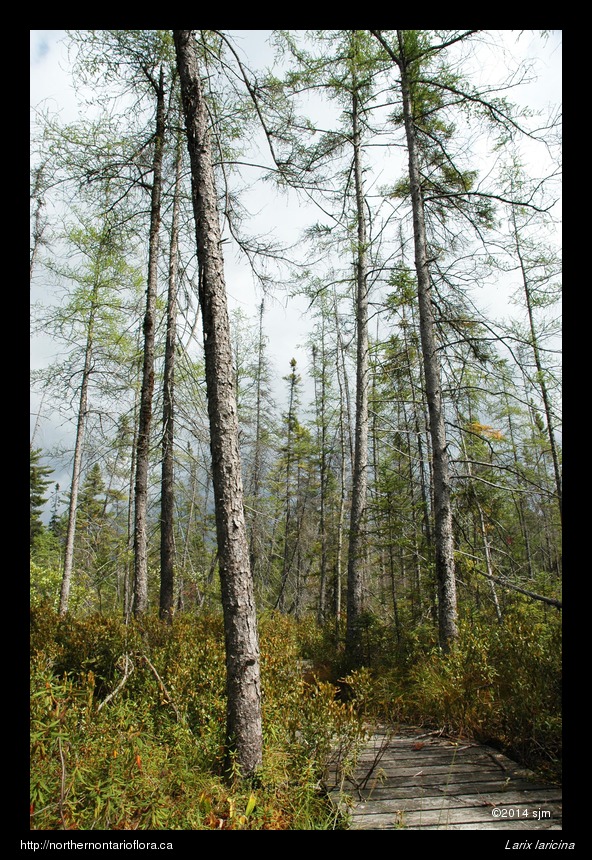
|
Northern Ontario Plant Database 
Plant DescriptionLarix laricina (DuRoi) K.KochEn: tamarack, eastern larch, 'juniper' [NL], hackmatack, black larch
Pinaceae (Pine Family) General: An open deciduous conifer, to 15-20 m tall, with horizontal to ascending branches. Tamarack is shallow rooted and very shade intolerant; its wood is decay-resistant and used for railway ties and posts. Stems/twigs: Young twigs are light reddish-brown and smooth (glabrous); older twigs are gray. Trunks of saplings and young stems have dark reddish-brown vertical ridges (from the decurrent leaf bases) against a dark brown background. Young shoots have dark reddish-brown terminal and lateral buds that are scaly and blunt to rounded; older shoots bear short shoots (spur shoots) that have only terminal buds. The bark of mature trees is gray to reddish-brown and scaly. Needles: Deciduous, simple, and sessile. Needles are slender, soft, glabrous, 1-2.5 cm long, green to bluish-green, and flat above, with a prominent midrib beneath; two thin white lines run along the lower length of each needle. The tips of the needles are blunt to rounded. On new shoots, needles are spirally arranged and attached directly to the stem by flat decurrent woody bases. On spur shoots, needles are crowded in terminal tufts of 15-60. Needles turn golden-yellow in the fall. Reproductive structures/cones: Unisexual, monoecious, with male and female cones appearing on the same main branches and emerging with the needles. Male cones consist of a low rounded cluster of light brown anthers terminating a 1- or 2-year-old spur shoot that lacks needles. Female cones are reddish, ovoid, and terminal on 2- or 4-year-old leafy spur-shoots. Immature cones are dark reddish-purple; mature cones are brown, ovoid, 1-2 cm long, and have 10-20 rounded cone scales. Cones develop in late spring and mature in fall; the winged seeds are shed from persistent cones at the end of the first growing season. Habitat and Range: In nutrient-poor peatlands, swamps, and low wet depressions. Larch is a boreal species that occurs throughout the Algoma District and across Ontario. Its Canadian range extends from Newfoundland & Labrador to the eastern interior regions of the Yukon and British Columbia. Similar Species: There are no other deciduous conifers native to Ontario, but in urban areas, a variety of European and Asian larch species may be found in parks and along streets; these can be differentiated by their much larger size (to 30 m tall) and larger cones (2-5 cm long). The most common introduced larch are Japanese larch (L. kaempferi (Lamb.) Carrière), European larch (L. decidua) Mill.), and their hybrid (L. ×marschlinsii Coaz), the Dunkeld larch. Back to species list |
||||||||||||||||||||||



















